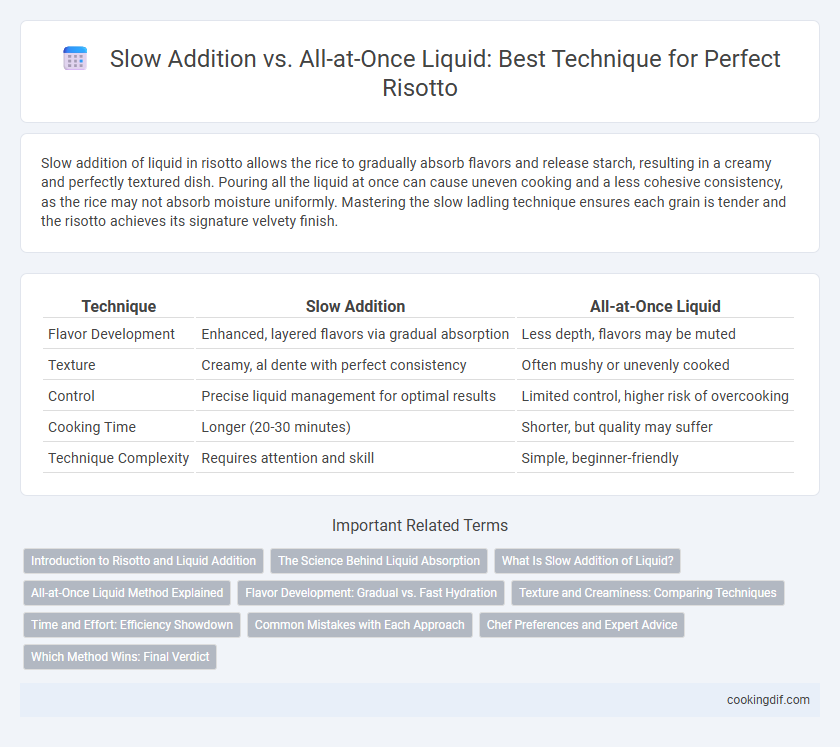Slow addition of liquid in risotto allows the rice to gradually absorb flavors and release starch, resulting in a creamy and perfectly textured dish. Pouring all the liquid at once can cause uneven cooking and a less cohesive consistency, as the rice may not absorb moisture uniformly. Mastering the slow ladling technique ensures each grain is tender and the risotto achieves its signature velvety finish.
Table of Comparison
| Technique | Slow Addition | All-at-Once Liquid |
|---|---|---|
| Flavor Development | Enhanced, layered flavors via gradual absorption | Less depth, flavors may be muted |
| Texture | Creamy, al dente with perfect consistency | Often mushy or unevenly cooked |
| Control | Precise liquid management for optimal results | Limited control, higher risk of overcooking |
| Cooking Time | Longer (20-30 minutes) | Shorter, but quality may suffer |
| Technique Complexity | Requires attention and skill | Simple, beginner-friendly |
Introduction to Risotto and Liquid Addition
Slow addition of liquid in risotto allows the rice to gradually absorb flavors and release starches, creating a creamy texture critical to traditional Italian risotto. Pouring all the liquid at once can lead to uneven cooking and a less cohesive consistency, as the rice lacks controlled exposure to the broth. Mastery of slow, incremental liquid incorporation is essential for achieving the signature creaminess and rich mouthfeel characteristic of authentic risotto dishes.
The Science Behind Liquid Absorption
Slow addition of liquid in risotto allows the rice grains to gradually absorb moisture, facilitating the release of starch that creates the dish's creamy texture. Pouring all the liquid at once risks uneven cooking and diminished creaminess because the rice cannot absorb the liquid at an optimal rate. Controlled, incremental liquid absorption maximizes starch gelatinization, ensuring a cohesive, velvety consistency characteristic of traditional risotto.
What Is Slow Addition of Liquid?
Slow addition of liquid in risotto involves gradually pouring warm broth into the rice, allowing each ladle to be fully absorbed before adding more. This technique promotes even cooking and optimal starch release, resulting in a creamy texture and rich flavor. Constant stirring during slow addition enhances the risotto's characteristic velvety consistency.
All-at-Once Liquid Method Explained
The all-at-once liquid method for risotto involves adding the entire volume of broth to the rice at the beginning of cooking, allowing it to absorb gradually without constant stirring. This technique simplifies preparation and reduces active cooking time while still achieving creamy texture, relying on precise temperature control to prevent burning or overcooking. It contrasts with the traditional slow addition method, which requires incremental liquid additions and continuous stirring to develop risotto's signature creaminess.
Flavor Development: Gradual vs. Fast Hydration
Slow addition of liquid in risotto technique promotes gradual starch release, resulting in a creamier texture and richer depth of flavor. All-at-once liquid hydration accelerates cooking but can lead to uneven starch gelatinization, producing a less creamy and more watery consistency. Controlled, incremental liquid incorporation enhances flavor complexity by allowing rice to absorb broth nuances fully during cooking.
Texture and Creaminess: Comparing Techniques
Slow addition of broth during risotto cooking promotes gradual starch release, resulting in a creamy and velvety texture. Pouring all the liquid at once leads to uneven starch absorption, often producing a less cohesive and drier consistency. The traditional slow ladling method remains preferred among chefs for achieving the signature creaminess characteristic of authentic risotto.
Time and Effort: Efficiency Showdown
Slow addition of liquid in risotto cooking allows gradual starch release, leading to creamy texture but requires increased attention and stirring, extending cooking time. Adding all liquid at once reduces active monitoring and lowers effort but risks uneven texture and potential overcooking. Chefs balance time investment and desired consistency by choosing the method that aligns with their efficiency priorities and culinary standards.
Common Mistakes with Each Approach
Adding the liquid all at once can lead to uneven cooking, resulting in mushy rice and unevenly released starch that affects risotto's creamy texture. Slow addition of broth allows gradual absorption and controlled starch release, but common mistakes include overheating the pan or failing to stir consistently, causing uneven cooking and clumping. Both techniques require careful temperature management and constant attention to avoid these typical pitfalls and achieve perfect al dente grains with a rich, creamy finish.
Chef Preferences and Expert Advice
Expert chefs emphasize the importance of slow addition of liquid in risotto preparation, highlighting that gradually incorporating warm broth promotes better starch release from the rice, resulting in a creamier texture. Conversely, the all-at-once liquid method, though quicker, risks uneven cooking and a less refined consistency, which many culinary professionals advise against for authentic risotto dishes. Techniques recommended by top chefs prioritize patience and incremental liquid addition to achieve optimal flavor and texture balance.
Which Method Wins: Final Verdict
Slow addition of liquid in risotto cooking ensures even starch release and a creamy texture, achieving the optimal balance between firmness and richness. Pouring all the liquid at once often results in uneven cooking and a less cohesive consistency. For a perfectly velvety risotto, the slow addition technique remains the superior method.
Slow addition vs All-at-once liquid for technique Infographic

 cookingdif.com
cookingdif.com